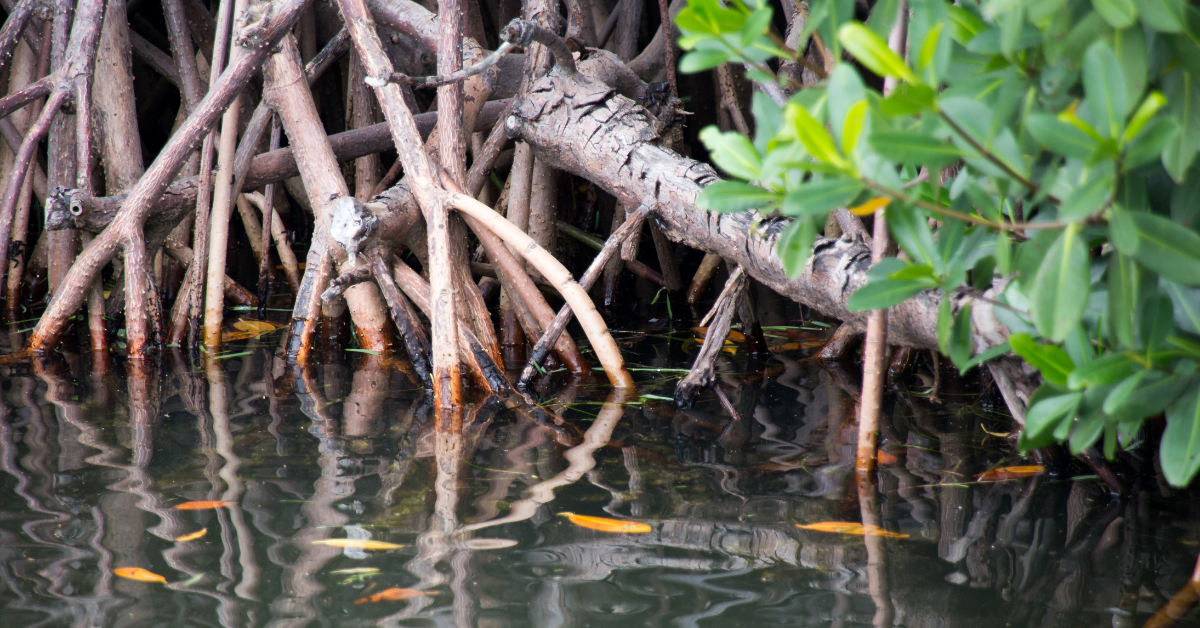Mangroves are one of the most biodiverse, and valuable ecosystems on the planet.
Like other complex and intricate ecosystems, they’re beyond priceless.
They provide essential habitat for the diverse fish and aquatic species that inhabit the mangroves.
Beyond their magical like beauty, it’s also extremely important to protect mangroves to help combat global climate change, and especially for a multitude of species, organisms, and beings that call them home.

According to the UN, roughly 75% of commercial fishing species spend at least part of their life cycle in mangrove ecosystems.
They depend on these ecosystems for food and proper growth into adulthood.
Thanks to mangroves’ complex rooting systems, complex variety of mangrove trees, and warm nurturing waters make them a very habitable and unique environment for the different adorable fish and crustaceans species.
Protecting mangrove forest ecosystems also means protecting the coastal communities. Because of the roots of the mangrove tree act as natural buffers against storm surges, floods and storms, and even hurricanes.
Mangroves also accumulate large amounts of CO2, which helps regulate and minimize the presence of it in the atmosphere.
Mangroves are considered natural sinks of carbon dioxide (aka Blue Forest), which store in massive deposits for tens of thousands of years similar to land forests and peatlands.
“Mangroves are part of a type of “Blue carbon ecosystem”, which includes seagrasses, salt marshes, and other wetlands.
Scientists believe that mangroves can store more carbon than tropical rainforests. This makes them true natural shields for protecting the environment, as they help offset the effects of climate.
Protecting mangroves are of astronomical importance, they are one of the trophic keys to fighting climate change, and preserving life on earth for future generations.

Mangrove conservation is absolutely vital both for the preservation of ocean, and coral reef fish species, and to sustain the life of humans around the world, especially global coastal communities.
The great threat of mangroves
Humans are rapidly destroying mangrove ecosystems around the world.
This threat is extremely rampant in Quintana Roo, Mexico, I’ve witnessed this tragedy with my own two eyes.
To make way and accommodate the massive influx of tourists, the government of Mexico is clearing large swaths of mangrove forests to develop the land for hotels and other tourist attractions.
Unfortunately, this seems to be the case with governments and land developers around the world.
Mangrove deforestation for development is only one piece of this complex puzzle.
Coastal development also increases pollution and the harmful discharging of sewage, and other manmade chemical pollution.
Already, more than 1/3 of the world’s mangrove forests have already disappeared just in the last 100 years.
It is a trend that can’t go on, it must be stopped immediately.
Education is Key
First, we educate global communities’ governments and global communities around the world.
Second, we must continue fixing and repairing damaged mangrove ecosystems via “Mangrove Restoration”, if we want these delicate and otherworldly ecosystems and the species that call them home to survive for our children to see.

Just in the last 40 years, we’ve lost over half of our mangrove habitats. Actively restoring and protecting mangroves is of paramount importance.
We have enough science to successfully correctly fix what we’ve done.
“Nature is the best legacy to leave behind to our children, nothing else comes close”.
Please consider supporting a Mangrove Nonprofit that is working to preserve, protect, and restore mangroves now, and for future generations.
Resources
Mangrove Data Portal
https://gma-panda.opendata.arcgis.com/
Mangrove Science
https://www.sciencedirect.com/topics/biochemistry-genetics-and-molecular-biology/mangrove

